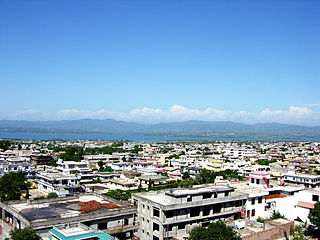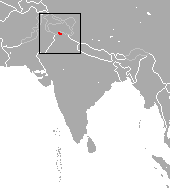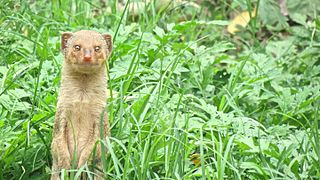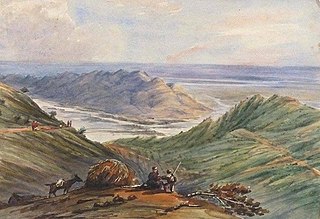
Azad Jammu and Kashmir, abbreviated as AJK and colloquially referred to as simply Azad Kashmir, is a region administered by Pakistan as a nominally self-governing entity and constituting the western portion of the larger Kashmir region, which has been the subject of a dispute between India and Pakistan since 1947. The territory shares a border to the north with Gilgit-Baltistan, together with which it is referred to by the United Nations and other international organizations as "Pakistani-administered Kashmir". Azad Kashmir also shares borders with the Pakistani provinces of Punjab and Khyber Pakhtunkhwa to the south and west, respectively. On its eastern side, Azad Kashmir is separated from the Indian union territory of Jammu and Kashmir by the Line of Control (LoC), which serves as the de facto border between the Indian- and Pakistani-controlled parts of Kashmir. Geographically, the administrative territory of Azad Jammu and Kashmir covers a total area of 13,297 km2 (5,134 sq mi) and has a total population of 4,045,366 as per the 2017 national census.

Kashmir is the northernmost geographical region of the Indian subcontinent. Until the mid-19th century, the term "Kashmir" denoted only the Kashmir Valley between the Great Himalayas and the Pir Panjal Range. Today, the term encompasses a larger area that includes the India-administered territories of Jammu and Kashmir and Ladakh, the Pakistan-administered territories of Azad Kashmir and Gilgit-Baltistan, and the Chinese-administered territories of Aksai Chin and the Trans-Karakoram Tract.

Muzaffarabad is the capital and largest city of Azad Kashmir, and the 60th largest in Pakistan.

Mirpur, officially known as New Mirpur City, is the capital of Mirpur district located in Azad Kashmir, Pakistan. It is the second largest city of Azad Kashmir and 74th largest city in Pakistan.

The Mirpur District is one of the 10 districts of Pakistan's dependent territory of Azad Kashmir. The Mirpur District is bounded on the north by the Kotli District, on the east by the Bhimber District, on the south by the Gujrat District of Pakistan's Punjab Province, on the south-west by the Jhelum District of Pakistan's Punjab Province, and on the west by Rawalpindi District of Pakistan's Punjab Province. The district is named after its main city, Mirpur. The Mirpur District has a population of 456,200 and covers an area of 1,010 km2 (390 sq mi). The district is mainly mountainous with some plains. The Mirpur District has a humid subtropical climate which closely resembles that of the Gujrat District and the Jhelum District, the adjoining districts of Pakistan's Punjab Province.

The Northwestern thorn scrub forests, presently known as Aravalli west thorn scrub forests, is a xeric shrubland ecoregion of Pakistan and Northern India, stretching along the border lowlands and hills between the two countries. Once covered in deciduous forest, this ecoregion has been degraded through agriculture and the extraction of timber so that it currently has a scanty covering of thorny scrub dominated by such trees as Acacia senegal, Acacia leucophloea and Prosopis cineraria. Where the soils are particularly saline, there are patches of semi-desert. A number of mammals are found in this habitat, including about four hundred species of bird. Some small areas are protected but the collection of firewood and the conversion of the land to subsistence farming continues.
Operation Gibraltar was the codename of a military operation planned and executed by the Pakistan Army in the disputed territory of Jammu and Kashmir in August 1965. The operation's strategy was to covertly cross the Line of Control (LoC) and incite the Muslim-majority Kashmiri population's uprising against the Indian Government. The military leadership believed that a rebellion by the local Kashmiri population against Indian authorities would serve as Pakistan's casus belli against India on the international stage.

The Deccan thorn scrub forests are a xeric shrubland ecoregion of south India and northern Sri Lanka. Historically this area was covered by tropical dry deciduous forest, but this only remains in isolated fragments. The vegetation now consists of mainly of southern tropical thorn scrub type forests. These consist of open woodland with thorny trees with short trunks and low, branching crowns; spiny and xerophytic shrubs; and dry grassland. This is the habitat of the great Indian bustard and blackbuck, though these and other animals are declining in numbers; this area was at one time home to large numbers of elephants and tigers. Almost 350 species of bird have been recorded here. The remaining natural habitat is threatened by overgrazing and invasive weeds, but there are a number of small protected areas which provide a haven for the wildlife. Trees in these forests have adapted to not require much water.

The Azad Kashmir Regiment, also known as AK Regt, is one of the six infantry regiments in the Pakistan Army. The regiment takes its name from Azad Kashmir, which is the Pakistani-administered territory of the Kashmir region. As per the order of seniority, it is the fourth regiment, but was the first to be raised after the independence of Pakistan from British colonial rule. Its regimental Centre is located at Mansar camp in Attock District, on the border of Punjab and KPK provinces. The regiment has participated in all major and minor operations and wars fought by the army. Notable commanders of the regiment include lieutenant general Haroon Aslam, an ex-commander of Pakistan Army Special Service Group who led the SSG operation in Swat in 2009, and lieutenant general Hidayat ur Rehman, who commanded Operation al-Mizan and operation Zarb e Azab in FATA from 2014 to 2016.

The wildlife of Pakistan comprises a diverse flora and fauna in a wide range of habitats from sea level to high elevation areas in the mountains, including 195 mammal, 668 bird species and more than 5000 species of Invertebrates. This diverse composition of the country's fauna is associated with its location in the transitional zone between two major zoogeographical regions, the Palearctic, and the Oriental. The northern regions of Pakistan, which include Khyber Pakhtunkhwa and Gilgit Baltistan include portions of two biodiversity hotspot, Mountains of Central Asia and Himalayas.

The Kashmir gray langur is an Old World monkey, one of the langur species. It is a leaf-eating monkey.
Kazinag National Park is a commissioned future national park in Baramulla city of the Baramulla district in the Indian union territory of Jammu and Kashmir. It is part of a proposal for a trans-Karakoram peace park with Pakistan. Kazinag national park located in North region of kashmir.The area of kazinag national park is 160 sq.kms.It was commissioned in 1992 A.D.The National park is located on the north bank of river jehlum.

The Western Himalayan subalpine conifer forests is a temperate coniferous forests ecoregion of the middle and upper elevations of the western Middle Himalayas of Nepal, India, and Pakistan.

The small Indian mongoose is a mongoose species native to Iraq and northern South Asia; it has also been introduced to many regions of the world, such as several Caribbean and Pacific islands.

Sheikh Badin National Park is located near Darra Pezu in the Dera Ismail Khan and Lakki Marwat districts of Khyber Pakhtunkhwa, Pakistan. It is located among the Sheikh Badin Hills, which is an eastern extension of the Sulaiman Mountains. The park was established in 2003 and covers an area of 15,540 hectares.
Malik Munawar Khan Awan was a Major rank officer in the Pakistan Army, whose career had begun in the British Indian Army and included spells in the Imperial Japanese Army and the revolutionary Indian National Army that fought against the Allies in World War II where he commanded 2nd INA Guerrilla Battalion during famous Battle of Imphal. He received a gallantry award for his work during Operation Gibraltar in 1965.
Sardar Muhammad Abdul Qayyum Khan was a Kashmiri politician who also served as the president and the prime minister of Azad Jammu and Kashmir (AJK). He also remained President of All Jammu and Kashmir Muslim Conference for over 20 years. He belonged to Dhund-Abbassi Tribe.
The Azad Kashmir Regular Force (AKRF), formerly known as the Kashmir Liberation Forces, were the irregular forces of Azad Kashmir until 1948, when they were taken over by the government of Pakistan and converted into a regular force. In this form, the unit became part of the country's paramilitary forces, operating out of the nominally self-governing territory of Azad Jammu and Kashmir. The AKRF was altered from a functioning paramilitary force and merged into the Pakistan Army as an infantry regiment following the Indo-Pakistani War of 1971.
Barnala is a city located in the state of Azad Jammu & Kashmir, Pakistan.
The Gurez National Park, also known as Musk Deer National Park, is one of the protected areas of Pakistan. It is located in Neelum District in Azad kashmir, Pakistan, besides the Neelum River in the Gurez valley. It is located in the high Himalayas and Pir Panjal Range. It is a thirty-five minute drive from Gurez tehsil. It is also known as Gurez valley national park.













